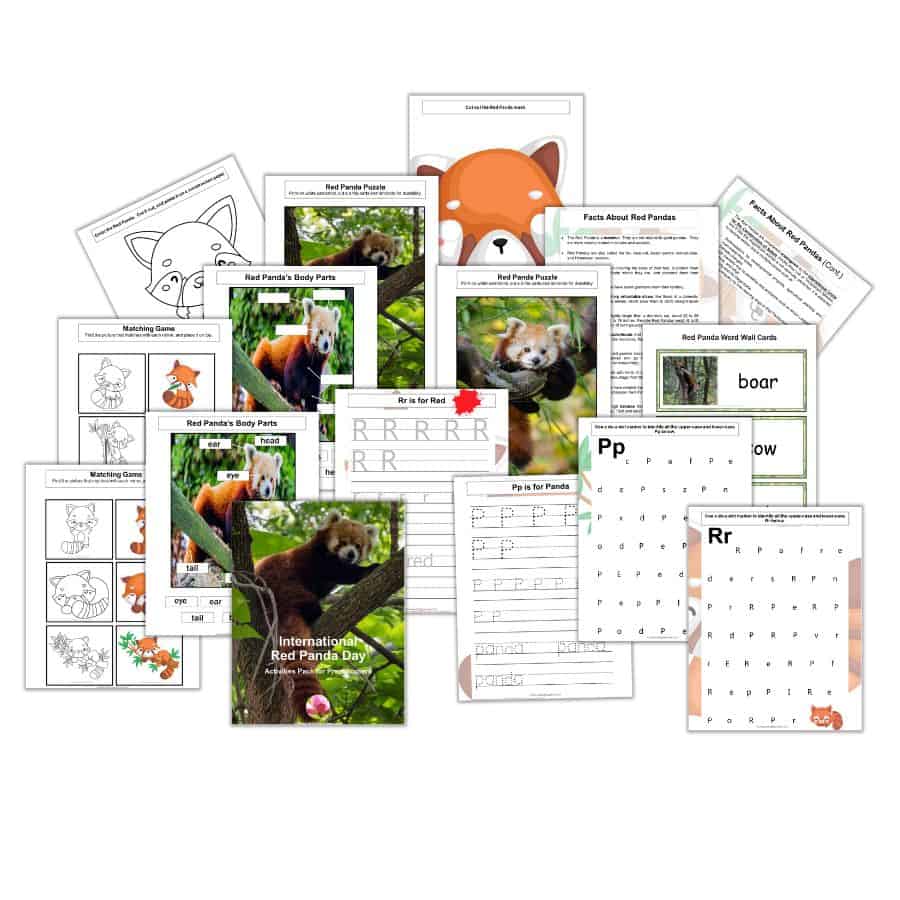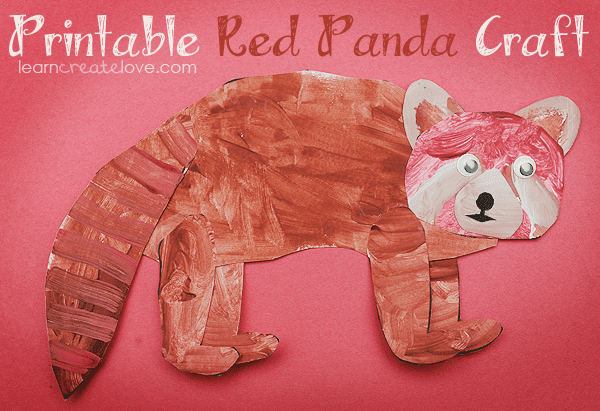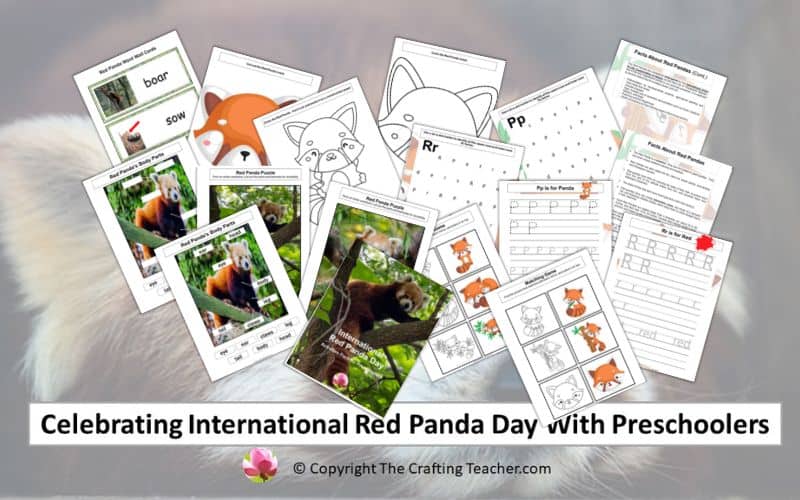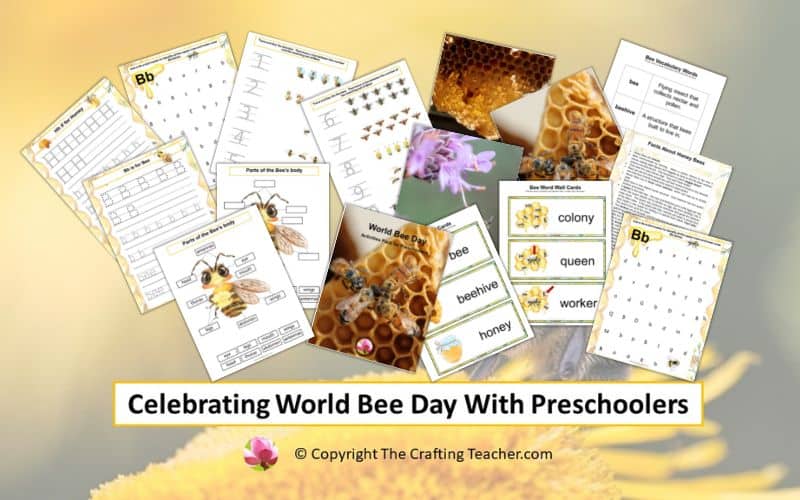Celebrating International Red Panda Day With Preschoolers
Affiliate Disclosure: “This post contains affiliate links, which means I receive a small commission, at no extra cost, if you make a purchase using those links.”
Every year, International Red Panda Day is celebrated on the third Saturday of September (this year is on September 17, 2022), to create awareness about this beautiful species that is already near extinction, trying to protect it and solve the problems that are causing this situation, which is mainly caused by us, humans.
History of International Red Panda Day
The Red Panda Network launched International Red Panda Day in 2010, celebrating this day for the first time in September. Since then, this campaign has been repeated around the entire world.
The Red Pandas were discovered in 1853 and in 2008, just 155 years after that, they will declare endangered. Since this animal is so elusive, scientists cannot tell how many individuals are left in the wild, but it is believed that just a few thousand remain.
Unfortunately, humans are the reason because they have caused impressive environmental damage in the Eastern Himalayas where the Red Pandas live, which includes countries such as China, Nepal, India, Myanmar, and Bhutan. The Red Pandas are legally protected in all these countries, but they don’t have enough funds, strong law enforcement, or conservation awareness to stop the destruction

At the end of this post, you will find a FREE International Red Panda Day pack, as my gift to you. It includes 23 pages of Literacy, Science, Math, and Fine Motor activities for your preschoolers.
You can find more information about International Red Panda Day and its programs HERE.
Importance of International Red Panda Day
The International Union for the Conservation of Nature (IUCN) Red List classifies Red Pandas as endangered. This magnificent species is on the way to extinction, and everybody must support International Red Panda Day and the efforts that organizations such as the Red Panda Network and the World Wildlife Fund (WWF) are making to protect Red Pandas because this day:
- Spreads information about Red Pandas globally, a species that might be unknown to a lot of people.
- Inform the public about the danger of extinction that this species is facing and why this is happening.
- Teach about things that we can do to save the Red Panda and why this species needs to be saved.
- Call attention to the Eastern Himalayas countries to enforce the protection laws better.
- Collects funds to help these countries fight against poaching and deforestation practices.
How to Celebrate International Panda Day
There are many things that each of us, teachers and parents of preschoolers can do, to celebrate this day and do our part to protect the Red Pandas. Here are some ideas I can give you for celebrating International Red Panda Day:
- Learn and teach facts about Red Pandas, to help make your preschoolers and their families get to know these cute animals, and encourage in them the desire to protect them.
- Have your preschoolers make this cute Red Panda-related craft by learncreatelove.com

- Make these adorable Red Panda Cookies with your preschoolers for a special snack to celebrate this day.

- Show your preschoolers videos about Red Pandas. These are two good ones:
- Become an ambassador for the Red Panda Network, by volunteering and holding a fundraising event at your school and/or community, to support this non-profit organization that works hard to raise awareness for the red panda and provide local communities in red panda habitat countries with resources and support.
- Inform your preschoolers, families, and friends about the extinction that Red Pandas are facing, their importance to the ecosystem where they live, and how people can save them.
- Visit the Red Pandas at a local zoo with your preschoolers and their families, to observe these beautiful creatures and/or attend any special activity that your local zoo is doing during International Red Panda Day.
- Use your social media platforms to share information about International Red Panda Day and everything that has to do with it, spreading awareness regarding this species and its risk of extinction.
- Support the World Wildlife Fund in its fight to protect red pandas within their natural habitat throughout India, Nepal, and Bhutan.
- Get involved with the Rainforest Trust to support its efforts to stop deforestation in the Eastern Himalayans where the red pandas live.
- You can make personal donations to organizations focused on the conservation of red pandas and other endangered species.
- Take one of the eco trips Red Panda Eco offered by the Red Panda Network if you can, to see Red Pandas in their habitat, become educated on the need to prevent forest exploitation, and participate in community-based conservation efforts.
- Become a Red Panda advocate and educate other people on the need to protect them.
Facts About Red Pandas
Some important Red Panda facts you can teach your preschoolers are these:
- The Red Panda is a mammal. They are not related to giant pandas. They are more closely related to skunks and weasels.
- Red Pandas are also called firefox, bear-cat, lesser panda, red-cat-bear, and Himalayan raccoon.
- Red pandas have thick fur covering the soles of their feet, to protect them from the cold of the altitude where they live, and prevent them from slipping on branches.
- The soles of their feet also have scent glands to mark their territory.
- Red pandas have very sharp retractable claws, like those of a domestic cat, and extremely flexible ankles, which allow them to climb straight down a tree, head first.
- Adult Red Pandas are slightly larger than domestic cats, about 22 to 25 inches, and their tails are 15 to 19 inches. Female Red Pandas weigh 6 to 10 pounds, and males usually 10 to 14 pounds.
- Red pandas have a pseudo-thumb that helps them grab bamboo stems and tree branches. And like raccoons, they also dip their paws into the water when they take a drink.
- When it gets cold red pandas become dormant, where they wrap their tail around themselves and go into a deep sleep (similar to hibernation, but seems to be involuntary).
- Their red, black, and white with hints of orange and yellow coloring, and black bellies help them camouflage from their predators.
- The Chinese Red Pandas have reddish tracks from their eyes to the corner of their mouth, and the Himalayan Red Pandas have a lot of white on their face.
- Red pandas live in the high bamboo forests mountains in Nepal, India, Bhutan, Myanmar (Burma), Tibet, and southern China.
- Red pandas are carnivores that love bamboo. They also eat grass, fruit, berries, eggs, mushrooms, flowers, grubs, insects, small animals, birds, and maple and mulberry leaves.
- Red pandas are most active in the early morning and late afternoon (crepuscular) spending most of the day resting in trees (arboreal).
- Red pandas are normally solitary creatures but come together in pairs in the breeding season.
- When feeling threatened, Red Pandas stand on their hind legs, bob their heads, arch their tails, let out their loudest call, and may even defend themselves with their sharp claws or release a foul smell from their scent glands. They also make other sounds as warnings including the “huff-quack” and a whistle.
- A male Red Panda is known as a boar, a female red panda is called a sow, and babies are called cubs.
- Female Red Pandas build several dens in hollow trees or tree stumps with leaves, grass, moss, and tree branches, and use them to move their babies from nest to nest, to protect them from predators.
- Their pregnancy lasts three months and gives birth to a litter of 2 to 4 cubs in the late spring and early summer.
- Cubs are born covered in thick gray fur that protects them from the cold, their eyes and ears are closed, and they weigh from 3 to 4 ounces.
- Red Pandas are the only species left in the Ailuridae family. There are two different species of the Red Panda: the Himalayan Red Panda is found in Nepal, northeastern India, Bhutan, and southern Tibet, and the Chinese Red Panda is found in eastern Arunachal Pradesh, Myanmar, and parts of China.
- In the wild, Red Pandas live 8 to 10 years, but in zoos, they can live 15 to 23 years.
- The Red Pandas are considered endangered by the International Union for the Conservation of Nature (IUCN) Red List of Threatened Species, and if this magnificent animal is not seriously protected, it is expected to become extinct due to multiple causes such as disforestation by developmental projects, agricultural planting, and man-made fires areas; climate changes; high mortality due to parasites and predators such as Snow Leopards, Martens, and dogs; poaching and the illegal trade, and herds accompany by free-roaming dogs in Red Panda territory.
Books About Red Pandas
Read books about Red Pandas to your kiddos, to reinforce your lessons and plant in them the desire to help these amazing creatures, as they get older.
Honestly, I don’t know many books about Red Pandas, but below are the ones that I know, which you can find on Amazon following by just clicking on the pictures to follow my links, for easy and fast access. You can probably find more books at your local library or used book store.









Pin It For Later
If you are in a rush and don’t have time to read the post and download the printable but want to save it for later, pin it to one of your Pinterest boards.

We, as educators and parents of preschoolers, have to do everything in our power to spread the word hoping to create consciousness about this situation and create in our children the desire to become defenders of the planet and its inhabitants for life, so that future generations can get to know and enjoy Red Pandas and other existing species.
I hope you enjoy these ideas and help you have fun during the International Red Panda Day celebration with your preschoolers. To get the FREE pack, you just have to click on the link below and put your information, for an immediate download.
Be happy, safe, and creative. I wish you well.
Love,

P.D. Please let me know if any of these ideas worked for you, or if you think I need to add or replace something. My goal is to help you in any way I can.







